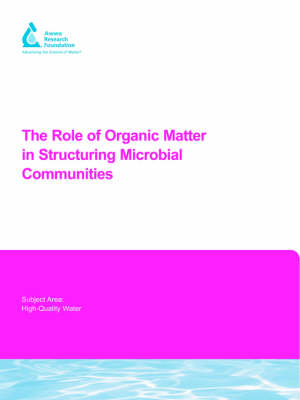Natural organic matter is important to the quality of drinking water. It constitutes precursors for disinfectant by-product formation and supports regrowth of bacteria. The drinking water industry is involved in work designed to improve biological treatment of water, control bacterial regrowth in distribution systems, and measure biodegradable NOM concentrations. These efforts would benefit from a knowledge of NOM composition and structure and the composition of microbial communities that colonize biological filters and distribution systems. In this project the researchers addressed four major goals: (1) to determine the structure and composition of natural organic matter (NOM), (2) to describe the structure of heterotrophic bacterial communities supported by raw and treated source water, (3) to measure the responses of heterotrophic bacterial communities to seasonally driven variations in NOM and temperature, and (4) to determine whether bioreactor systems can serve as small-scale models for the development and refinement of drinking water treatment processes. The five source waters selected for this project included a broad range of physiographic provinces, vegetation zones, and NOM concentrations. The research team analyzed NOM and microbial communities from an analytical hierarchy involving assessment of concentration, composition, and structure. Concentrations of NOM and BOM were estimated from dissolved organic carbon (DOC) and biodegradable DOC concentrations. NOM composition was assessed from analyses of carbohydrates with ion chromatography with pulsed amperometric detection, humic substances with XAD-8 resin, and functional groups with NMR. Molecular structure was determined from tetramethylammonium hydroxide thermochemolysis (TMAH) GC/MS. Microbial community composition was assessed from comparative ribosomal ribonucleic acid (RNA) sequencing, specifically, terminal restriction fragment length polymorphisms (t-RFLP), to provide an overview of microbial population structure and detect population shifts at the level of species. NOM Composition NOM and BOM concentrations showed extensive temporal variation in all of the source waters, but a general pattern of concentration ranges was discernable, indicating that each watershed has a particular concentration signal. Compositional studies revealed that humic substances and complex carbohydrates are components of both NOM and BOM. Structural and compositional studies identified unique NOM signatures for the different source waters, with some classes of molecules observed only in specific source waters. The BOM pool included humic substances and lignin, sources generally presumed to be relatively resistant to biodegradation. Additional novel insights included the quantitative contribution of aromatic molecules to the BOM pool and the potential for bacterial demethylation of lignin. Bacterial Communities The communities of microorganisms that developed in bioreactors that were fed water from different watersheds were unique. NOM influenced the genetic composition of resulting microbial communities, and seasonal shifts were observed for watersheds possessing strong seasonal temperature signals. Thus, temperature and organic matter quantity and quality probably influenced parameters important to the biological treatment of drinking water. A comparison of bioreactor metabolism with rapid sand filters showed some overlap, suggesting the bioreactors may indicate the ultimate potential of rapid sand filters for BOM processing. The researchers recommend the following: Bioreactors designed to monitor a BOM source should ideally be inoculated, colonized, and maintained by that source; at a minimum, acclimation to the source over several months is needed. Seasonal changes in the microbial community colonizing a biologically active filter may diminish filter performance and require an acclimation period to restore performance. Molecular-based methods for both microbial and chemical analyses of drinking water and treatment processes should be targeted for continued development and implementation within the drinking water industry. Originally published by AwwaRF for its subscribers in 2004.
- ISBN10 1843398974
- ISBN13 9781843398974
- Publish Date 1 March 2005
- Publish Status Out of Print
- Out of Print 2 March 2017
- Publish Country GB
- Imprint IWA Publishing
- Format Paperback
- Pages 116
- Language English
- URL http://iwapublishing.com/books/9781843398974/role-organic-matter-structuring-microbial-communities
